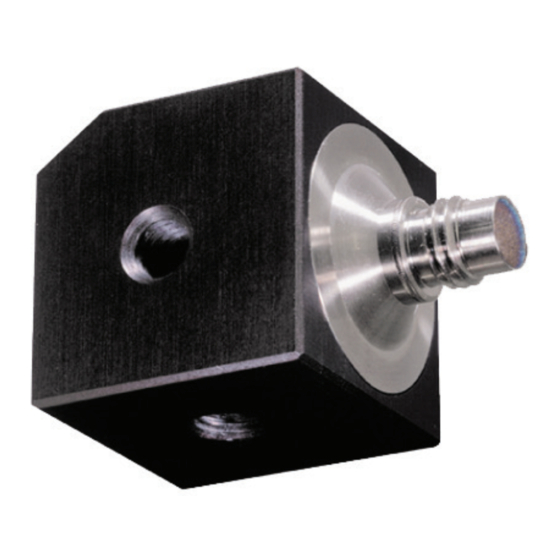
Summarization of Contents
Important Information
For Your Safety
Safety instructions for handling the accelerometer and ensuring safe operation.
Precautions
Precautionary measures for safe and reliable operation, including environmental and handling guidelines.
Disposal of Electronic Equipment
Guidelines for proper disposal of electronic equipment at the end of its lifecycle.
Product Description
Piezoelectric Measurement Concept
Explanation of how piezoelectric accelerometers convert acceleration into electrical charge.
Ceramic Annular Shear Background
Details on the annular shear sensing element and its advantages over compression designs.
Low Impedance (IEPE) Output
Description of the internal electronic circuit converting charge to low-impedance voltage output.
Studs
Details on mounting studs for accelerometers, including dimensions and types.
Cables
Information on various cable types available for connecting accelerometers, including specifications.
Nomenclature
Glossary of terms and designations used in the manual for ceramic shear sensors.
Installation
Surface Preparation
Requirements for preparing mounting surfaces to ensure optimal frequency response and accuracy.
Screw and Stud Mounting
Step-by-step instructions for mounting accelerometers using screws or studs, including torque specifications.
Direct Adhesive Mounting
Guidelines for using cyanoacrylate or epoxy adhesives for mounting accelerometers.
Mounting with Wax
Instructions for using wax as a mounting agent for lightweight sensors in temporary installations.
Summary of Mounting Methods
A comparative overview of different mounting methods, their advantages, disadvantages, and remarks.
Securing Cables
Recommendations for properly securing cables to prevent fatigue failures and ensure reliable connections.
Mass Loading Effects
Explanation of how accelerometer mass can affect measurement accuracy and guidelines for minimizing these effects.
Operating Instructions
Powering
Essential information on powering the accelerometers using internal or external power sources and couplers.
Using "Built-In" Power Sources
Using FFT analyzers and vibration monitors with internal accelerometer power supplies.
Kistler Couplers
Information about Kistler's line of power supply/couplers and dual mode amplifiers.
The Constant Current Power Supply/Coupler
Understanding the function of constant current power supplies and their role in accelerometer operation.
Sensor Power-Up
Procedure for powering up the sensor and the expected output signal behavior.
Overload Recovery
How the accelerometer components are protected from overload and the time required for recovery.
Supply Voltage Effects
The impact of fluctuations in supply voltage on accelerometer sensitivity and noise level.
Driving Long Cables
Guidelines for using long cables with accelerometers, including current requirements and frequency response.
Ground Loops
Causes of ground noise and how ground loops can affect measurements.
Ground Isolation
Methods to eliminate ground loops by isolating the accelerometer from the test article.
Frequency Response Limits
Understanding the inherent mechanical and electrical limitations on accelerometer frequency response.
Frequency Response Definition and Standards
Definition of frequency response and industry standards for accuracy and variations.
High Frequency Limitations
Factors affecting the high-frequency limit, including mechanical resonance and sensitivity rise.
Low Frequency Limitations - Accelerometer
Electrical limitations on low-frequency response due to the amplifier input circuit acting as a high-pass filter.
Low Frequency Limitations - Coupler and Read-Out Instrumentation
How couplers and measurement instrumentation affect the low-frequency response of the system.
Calibration and Maintenance
Calibration
Determination of accelerometer sensitivity by comparison to a NIST traceable standard accelerometer.
Maintenance
Procedures for cleaning the accelerometer and its connector, and recommendations for factory repair.
















Need help?
Do you have a question about the 8763B Series and is the answer not in the manual?
Questions and answers